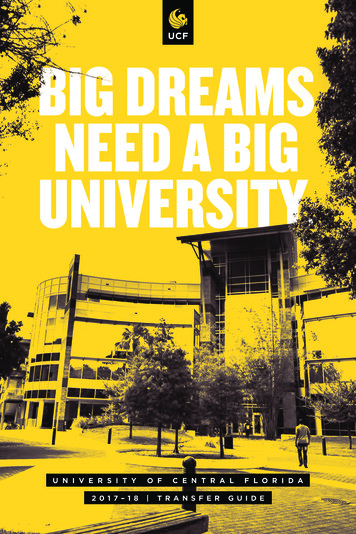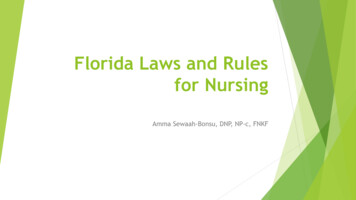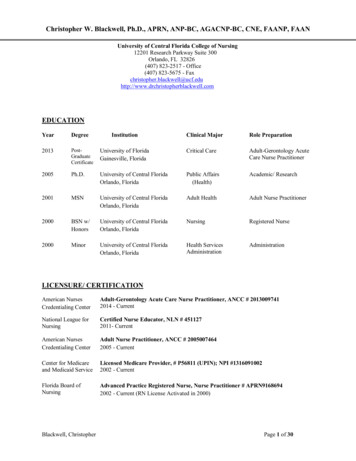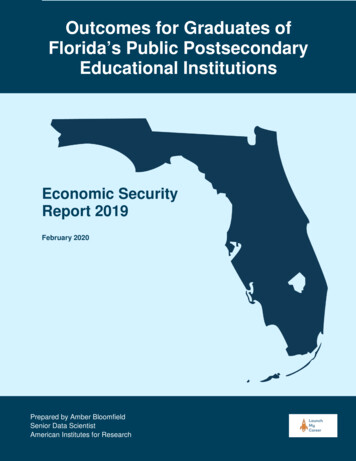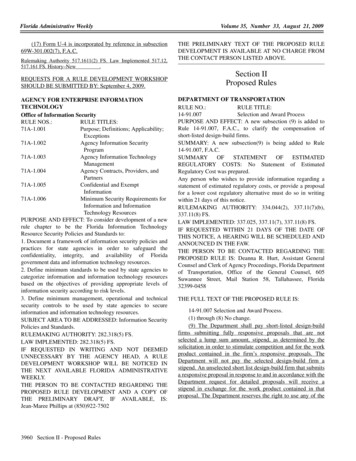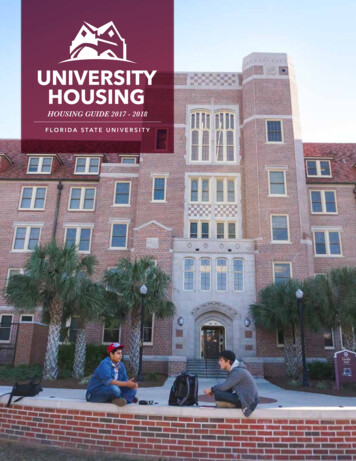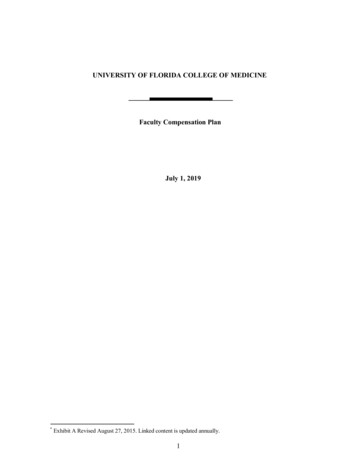
Transcription
UNIVERSITY OF FLORIDA COLLEGE OF MEDICINEFaculty Compensation PlanJuly 1, 2019*Exhibit A Revised August 27, 2015. Linked content is updated annually.1
Table of ContentsIntroduction . 3Base Salary . 4Compensation Score . 5Patient Safety and Quality . 6Base Pay Adjustments for Clinical Assignments . 6Base Pay Adjustments for Research Assignments . 7Administrative Supplement . 8Individual Teaching Incentive .8Individual Research Incentive . 9Individual Clinical Incentive . 12Endowments and Contracts . 13Year-End Departmental Incentive . 13Compensation Plan Database. 14Appeals, Resolution of Conflicts and Grievances . 14Timeline . 142
INTRODUCTIONThe goal of the University of Florida (UF) College of Medicine (COM) faculty compensation plan is toassure the fiscal health of the COM while simultaneously promoting and rewarding individual success inteaching, research, service and patient care through monetary incentives.The compensation plan covers both clinical and basic science faculty employed by the COM. All facultyemployed in salaried, benefits-eligible positions participate except: (1) faculty reporting to COM leadershipin Jacksonville (COM faculty employed at the Jacksonville regional campus are covered under a separatecompensation plan), (2) OPS and Emeritus faculty, (3) postdoctoral associates and research associates, (4)visiting faculty, (5) Advanced Registered Nurse Practitioners and Physician Assistants, and (6) facultyspecifically exempted by the Dean.A new faculty member who is employed after the first business day of the fiscal year may be included inthe plan if the position is included in the department’s annual budget and the faculty member has beengiven an appropriate assignment and, for clinical faculty, a work Relative Value Unit (wRVU) target.The COM financial health must be preserved by ensuring that revenues exceed expenses annually. WhenCOM revenues exceed expenses, the margin will be distributed to: (1) a faculty incentive pool, (2) a yearend departmental incentive pool, and (3) COM reserves. The Dean of the COM will determine, with inputfrom the department chairs and the faculty council, the distribution of excess revenue to the incentive pool,year-end departmental incentive pool and COM reserves.Faculty members are compensated with base pay and may receive incentive pay and/or year-enddepartmental incentive pay if performance measures are met or exceeded. Collectively, a department’sproductivity must minimally achieve a balanced budget. Although dollars are not budgeted for the incentiveor year-end departmental incentive pools, the department chair must estimate revenue generation necessaryfor historical incentive and year-end departmental incentive payments. This amount must be recorded in thebudget process and progress tracked throughout the academic year.The COM Compensation Committee will continually review and recommend to the COM ExecutiveCommittee revisions to the COM Faculty Compensation Plan. Without revising the plan, incentivepayments or other elements of this plan may be modified in specific cases where the College of Medicinefails to meet its budget targets, as determined by the Dean. To encourage flexibility and creativity incompensation arrangements, the Dean may approve departmental compensation plans, which differ fromthe terms of this compensation plan.Research and clinical subcommittees of the Compensation Committee are available to makerecommendations to chairs or the Dean, as appropriate, about disputes, conflicts, or questions surroundingfaculty compensation.3
BASE SALARYBase salary is a faculty member’s fixed contracted salary.Base salary, also referred to as “Fixed/Contractual Salary Plus Medical Practice Supplement” in theAssociation of American Medical Colleges (AAMC) Faculty Salary Survey, will be subject to anestablished floor and ceiling, stratified for rank and specialty (EXHIBIT A). A faculty member’s basesalary cannot be reduced below the AAMC 20th percentile, and cannot exceed the AAMC 75th percentile,except as noted below. It is the intent of the COM to provide appropriate total compensation withoutinflating base salary. When annual faculty salary increases are authorized by UF or the COM, facultyabove the 75th percentile may be granted a payment in lieu of a base salary adjustment. Other externalbenchmarks in lieu of the AAMC 75th percentile ceiling may be used with the approval of the Dean. Forbasic science faculty and PhD’s in clinical departments, base salary is subject to the AAMC 20th percentilefloor but not the ceiling.Total compensation is comprised of base salary, administrative supplements, productivity incentives, yearend departmental incentives, and one-time payments. Total compensation may not exceed fair marketvalue.Base salary may be adjusted annually in accordance with UF and COM guidelines and based on the facultymember’s performance. Base pay adjustments may be positive or negative and should be aligned with theoverall performance of a faculty member. Positive base pay adjustments may include, but are not limitedto, mandatory state raises1, promotion-associated raises and merit-based raises supported by the annualevaluation. Negative base pay adjustments may occur when overall performance, as determined bycompensation score (see below), does not achieve expectations or when minimally acceptable productivitymeasures are not achieved for clinical and/or research assignments. Therefore, negative base payadjustments may occur through two mechanisms- the compensation score and/or failure to achieveproductivity targets. Negative base pay adjustments related to clinical and/or research productivity whichis not the result of a protected event or condition will occur mandatorily unless specifically exempted bythe clinical or research sub-committees of the Compensation Committee following review of a facultymember’s appeal that includes a profit-loss statement and a letter of support by the department chair.Faculty members will not be subject to negative base pay adjustments in the first 36 months of appointmentunless COM and/or department financial circumstances warrant revised financial considerations. Inaddition, negative base pay adjustments related to performance will not occur when productivity wasimpacted by conditions protected by law (such as, by way of illustration, personal or family illness) or achange in assignment that results in unanticipated low productivity. Other sources of appropriate salarysupport, such as revenue derived from assignments fulfilling University contracts or foundation supportdetermined by the chair to be appropriately applied to the faculty member’s efforts will be considered as partof clinical or research productivity by converting these dollars to wRVU or research salary supportequivalents.For purposes of determining eligibility for across-the-board salary increases authorized by the state ofFlorida or UF, a faculty member’s total compensation score will be used to determine his/her overall levelof performance. In addition, such raises will only be applied to the percent FTE/salary of the facultymember that was determined to be satisfactory.41
Compensation ScorePay, in each mission area, may be affected by the annual compensation score, either positively or negatively. Basedon annual evaluations and performance, department chairs will assign faculty a compensation score in each missionarea of assigned time to calculate a total compensation score as indicated in the table below. Scores are assigned ona 5 point scale, where 0 to 1.9 is unsatisfactory, 2.0 to 2.9 is below performance standards, 3.0 to 3.9 is for achievingperformance standards, and 4.0 to 5.0 is for exceeding performance standards. Chairs will adjust the patient carecompensation score plus/minus 25 percent based on the patient safety and quality metrics FTE AdjustedCompensationScoreNon-Clinical TeachingResearchServicePatient Care With or WithoutClinical TeachingVeterans Health AdministrationTotal compensation score100 %Faculty are eligible for annual merit increases when authorized by UF, incentives, and year-end departmentalincentives based upon the faculty member’s total compensation score according to the table below. Faculty whoreceive a compensation score below 3.0 in any assignment area will be subject to up to a 10% reduction in base salaryfor those assignment areas where their score is below 3.0 as outlined in the table below. The Dean will decidethe effective date of a salary reduction.Compensation ScoreOutcome4.0 to 5.0Exceeds Performance Standard. Eligible for merit increase,incentives, and year-end departmental incentive.*3.0 to 3.9Achieves Performance Standard. Eligible for merit increase andincentives.*2.0 to 2.9Below Performance Standard. Base salary will be reduced 5percent in the applicable assignment area. Not eligible forincentives or year-end departmental incentive.0.0 to 1.9Unsatisfactory Performance. Base salary will be reduced 10percent in the applicable assignment area. Not eligible forincentive or year-end departmental incentive.*Higher performance scores may result in higher merit increases and year-end incentive.Reductions in salary as a result of compensation scores below 3 are independent and additive to salaryreductions which may result from the mechanisms described below under the headings: Base Pay5
Adjustments for Clinical Assignments and Base Pay Adjustments for Research Assignments. The totalsalary adjustment from all mechanisms cannot exceed 10% of total salary in any one year.The processes for appeals, resolution of conflict or grievances may be found on page 14.Patient Safety And QualityTo emphasize the importance of patient safety and quality as a distinct faculty responsibility, clinicalcompensation scores will reflect safety and quality of care delivered. The patient care compensation scorewill be adjusted 25 percent, based on departmentally determined safety and quality metrics, to align thefaculty incentives with the current strategic plan of the UF & Shands Academic Health Center, and toreward high quality and safe patient care.Each department determines its quality metrics. These metrics are reviewed by the Patient Quality andSafety Executive Committee (comprised of all physician directors of quality (PDQ) and Shands Hospitalleadership), and are expected to accurately reflect individual performance in this area. Performance onthese metrics will be used to determine the quality component of the faculty compensation score. Examplesof metrics that may be measured by a department include meeting Physician Quality Reporting Initiative(PQRI) metrics, patient satisfaction evaluations, core measures, and effectiveness measures suchas the Surgical Care Improvement Project. In addition, effective physician leadership is a key to improvingand sustaining a safe patient care environment, and evidence of effective leadership will be factored intothe quality metrics for each faculty. Examples include serving as a unit based physician leader within ahighly effective clinic or hospital unit, managing a quality project with measurable positive results and oreffectively serving as a PDQ are all examples of physician leadership.Base Pay Adjustments for Clinical AssignmentsClinical productivity, measured by wRVU generation, should minimally exceed the 25th percentile of theUHC specialty benchmark adjusted for clinical effort for each faculty member with a clinical assignment.In circumstances where the 25th percentile of wRVU production is not surpassed (and the lack ofproductivity is not the result of a protected event or condition), mandatory review of the presumptive salarydecrease by the clinical sub-committee of the Compensation Committee will occur and the faculty memberwill be notified of the presumptive decrease and review in writing by the College of Medicine’s FinancialServices Division. Within 10 days of receipt of the notice, the faculty member may appeal to the chair forsupport for relief from the salary decrease. If the chair declines the appeal, the decision is final. If thechair accepts the appeal, the faculty member may appeal the base pay adjustment to the Dean by providingthe clinical sub-committee written documentation of an assignment change, alternative salary support orother extenuating circumstances. A chair’s letter of support must accompany the faculty member’s appealas well as a profit-loss statement for the faculty member for informational purposes. The sub-committeewill advise the Dean on its recommendation and the Dean will decide the appeal. If the appeal is denied,the faculty member’s base pay will be reduced by 10%. Negative base pay adjustments will not occur ifthe faculty member’s base pay is at or below the 20th percentile of the AAMC salary benchmark. Base paymay be restored, at the chair’s discretion, with annual clinical activity that exceeds the 25th percentile of theUHC specialty benchmark adjusted for clinical activity.6
In years that raises are available, individuals receiving negative salary adjustments will not be eligible forraises based on that area of their assignment triggering the salary reduction but will be eligible for raisesbased on other areas of their assignment. Any raise amounts will be calculated after applying the negativesalary adjustment.Base Pay Adjustments for Research AssignmentsResearch AssignmentsFor compensation plan purposes research shall be classified into one of two categories: Category 1 orResearch 1 assignments are for research assignments where there is the expectation that the researchactivities performed are competitive for extramural funding and that there is an expectation that extramuralfunds will be applied for and that ultimately extramural funds will be secured to support, wholly or in part,the research assignment. Category 2 or Research 2 assignments are for research assignments where there isno expectation that the activities preformed under the assignment will be competitive for extramural fundingand there is no expectation that applications for extramural funding will result from a Research 2assignment. Individuals with Research 2 assignments will not participate in the research incentive programunder the compensation plan nor will they be subject to automatic salary reductions due to lack ofextramural research funding. They may however still be subject to reductions in salary resulting from lack ofperformance in the assignments area based on other criteria such as lack of engagement in structuredresearch activities.For promotion and tenure purposes, Research 1 and Research 2 assignments are recognized equivalently asone’s Research Assignment and will not be distinguished on one’s promotion and tenure dossier. Forpromotion and tenure purposes research expectations are equivalent regardless of compensation plandesignations or expectations.Individual Research AssignmentsIndividual faculty members with research assignments shall have either a Research 1 or Research 2 assignment.The research assignment cannot be split between Research 1 and Research 2 in any given fiscal year.Research Productivity Related Base Pay AdjustmentsFor faculty members with Research 1 assignments, if the research salary coverage by extramural grants andother restricted funding sources is less than 25% of the NIH cap-adjusted research salary for the justcompleted fiscal year, and the 3 (three) year rolling average research salary coverage by extramural grantsand other restricted funding sources is also less than 25% of the NIH cap-adjusted research salary, then thetotal research salary will be reduced by 10%. Once a faculty member’s salary reaches the 20th percentile ofAAMC salary benchmark, no further reductions will occur.In years that raises are available, individuals receiving negative salary adjustments will not be eligible forraises based on that area of their assignment triggering the salary reduction but will be eligible for raises7
based on other areas of their assignment. Any raise amounts will be calculated after applying the negativesalary adjustment.Restoration of salary will result as soon as extramural or restricted salary recovery is restored to a level thatequals at least 60% of the NIH cap-adjusted research effort assignment that originally triggered the salaryadjustment mechanism.Request for exemption due to mitigating circumstances from negative salary adjustments must be presentedin writing from the department chair to the Compensation Committee, which will review the specificcircumstances and will make a recommendation to the Dean. The Dean will have ultimate authority ingranting or denying the request for exemption.Administrative SupplementAn administrative supplement may be provided for significant administrative responsibilities.Administrative supplements are considered part of a faculty member’s base salary. When a facultymember’s administrative assignment ends, any administrative supplement associated with that assignmentis removed from the faculty member’s base salary. One-time payments paid to faculty members foractivities such as additional duty or responsibilities are temporary and are not included in base salary.INDIVIDUAL INCENTIVESIn order to receive an incentive payment, a faculty member must be employed with the College ofMedicine in a faculty position through June 30th of the current year.Individual Teaching IncentiveTo recognize outstanding performance in teaching, an incentive/award may be available from the COMOffice of the Dean for a select number of educators. Eligible faculty shall be nominated by the Chairfrom each COM Gainesville department. Each year, up to 10% of the faculty shall be selected based ontheir excellence of teaching of medical students, residents and fellows, physician assistant students,graduate students, post-docs, and mentorship of junior faculty.To qualify for an award of excellence in teaching, candidates must have no compensation grade lessthan 3.0 in any mission and a teaching assignment of at least 15%. If extenuating circumstances existsuch that a department chair believes a particular faculty member deserves consideration for the awardwith less than 15% time assigned to teaching, the nomination can proceed with a request to the awardscommittee to excuse the 15% teaching assignment requirement. Department chairs are not eligible forthe teaching incentive/award.Each department may nominate one or more faculty meeting the criteria referenced above. Themaximum number of nominations by a department shall be proportionate to the department’sassigned teaching FTE. This number is determined by calculating the sum of the teaching FTEassignment of faculty in each department for the academic year and may be rounded up to the nextwhole number. The total number of teaching incentive/awards will equal no more than 10% of the totalCOM faculty headcount.8
Chairs will submit nominees unranked with a brief paragraph justifying the nomination including asummary of the candidates teaching activities, emphasizing teaching accomplishments, andevaluations by students and mentored junior faculty.Nominees with educational FTE assignment of 15-30% will receive 1500 and faculty with FTE of 31%and above will receive 2500.The Educational Awards Committee may allocate up to 10 additional awards to faculty (with theirchair’s approval) for recognition based on their education contributions.The Educational Awards Committee shall be comprised of the following individuals:1. Senior Associate Dean for Education or designee serves as chair of the selection committee.2. Associate Dean for Graduate Education.3. Associate Dean for Medical Education.4. Associate Dean for Graduate Medical Education.5. Director of the Physician Assistant Program6. Basic Science Chair appointed by the Dean7. Clinical Department Chair appointed by the Dean8. President of the Faculty Council or his/her designeeAs the faculty grows the number of awards will grow. The award amounts are subject to theavailability of funds and may increase or decrease as needed to meet COM budget requirements.Individual Research IncentiveTo participate in the individual research incentive, a faculty member must have time assigned toResearch 1. Individuals with Research 2 assignments will not be eligible for research incentive payments.In addition, to be eligible for an individual research incentive, a faculty member must have a facultyappointment of greater than 36 months in duration and 0.20 FTE time assigned to research and anassistant professor (for up to five years or until promotion to associate professor, whichever occurs first)must have 0.30 FTE assigned to research. However, department chairs can request approval of theCompensation Committee for participation in the individual research incentive by faculty with anappointment less than 36 months in duration and FTE 0.20 or by assistant professors with FTE 0.30,who, in spite of their small amount of time dedicated to research, have obtained grant support for theirresearch salary and have a profit-loss statement that demonstrates research salary coverage.To provide an incentive for faculty to seek salary support from research grants, the percentage of researchFTE salary covered by grants will be used to calculate a research incentive according to the table below.For the purpose of the incentive, research salary support will be provided primarily by extramural, peerreviewed grants. Research grants and research contracts, including industry sponsored research, count9
towards the research incentive if they specify salary support and are awarded with indirect costs. Salarypaid by a research career development award, including Veterans Affairs (VA) mentor research trainingprograms, is included in the incentive. For salary offsets to count towards the research incentive, thefaculty member must be the principal investigator, co-principal investigator or a co-investigator who hasmade a significant intellectual contribution to the grant application as determined by the chair afterconsultation with the principal investigator.Incentives for grant supported salaries are calculated as a percent of base salary allocated to research foreach category of the proportion of research FTE covered by grant funding, as indicated in the table below.For example, if a faculty has .6 FTE assigned to research and .3 FTE (or 50%) is covered by grants, theincentive will be calculated as 2% of the .6 salary allocated to research. For faculty whose salary rateexceeds a cap determined by a funding agency (e.g., NIH cap on salary), determination of the “salarycovered” will be based upon the FTE assigned to the grant (relative to the faculty member’s total FTEassigned to research), not the actual amount of funding awarded by the granting agency for that FTE.Likewise, the incentive will be calculated as a percentage of the salary excluding non-research relatedadministrative supplements allocated to the research FTE, not the actual salary covered because of thegranting agency’s cap.In the event that the sum of all calculated faculty incentives exceed the designated faculty incentive pool,faculty incentives will be prorated proportionally.Base Salary Covered by GrantsAdjusted for Research FTE50% or more60% or more75% or more90% or moreIncentive as a Percent of BaseSalary Allocated to Research2.03.04.56.0If a faculty member qualifies for an incentive and the calculated award is less than 250, the actual awardhe/she would receive is 250.To provide incentives for newly appointed assistant professors who are developing a research program,recognizing that it is often difficult for these individuals to secure the level of funding indicated above, thefollowing will apply. For up to five years as an assistant professor or until promotion to associateprofessor, the table below will be used to calculate the faculty member’s incentive. To participate in thisprogram, an assistant professor must have 30% time assigned to research. (Department chairs can requestapproval of the Compensation Committee for participation in the individual research incentive by assistantprofessors with FTE 0.30 who have 20% or more of their research salary supported by grants.)Base Salary Covered by Grants forqualified Assistant ProfessorsAdjusted for Research FTE 20%30% or moreIncentive as a Percent of SalaryAllocated to Research2.03.010
45% of more60% or more4.56.0Additional incentives will be given to promote and reward investigator-initiated, peer reviewed,competitive, large-scale research grant/contract awards. To encourage large grants that involve multipleinvestigators such as Program projects and Center grants, in which each investigator contributes aseparately funded project or a separate project with a dedicated budget, additional research incentives arealso provided. Incentives are given for each year of the research award, for grant/contract expenditures toUF that specify salary support for the principal or lead investigator (PI) and pay indirect costs, inaccordance with the table below:Research ActivityPI or lead investigator on a competitive, peer-reviewed Program Project,center or comparable multiple grant award, with direct costs greater than 750,000 per year.PI or lead investigator on a competitive, peer-reviewed training grant,with direct expenditures greater than 100,000 per year. (This incentiveis calculated as 3% of the PI’s assigned research salary.)PI or lead investigator on investigator-initiated, competitive, peerreviewed grant(s), including subproject(s) of a competitive, peerreviewed Program Project, center or other multiple grant award(s) withtotal direct expenditures:Incentive as Percentof Salary Charged toResearch Grant6345 100,000 per year 500,000 per year 1,000,000 per year67 2,000,000 per yearPI on VA Merit Review Award with direct expenditures of 150,000and at least a 5/8 appointment to the VHA. 1,500Incentive payments will be pro-rated for grants less than 150,000.The incentive that accrues to the investigator will be calculated and paid based on the amount of base salaryexcluding non-research related administrative supplements allocated to the research FTE, not the salarycapped by a granting agency. If a grant was open for nine months, but salary was charged to the grant foronly two months, then only two months of salary offset would be used to calculate the incentive amount.Fringe benefits will not be paid on incentives. To ensure that balance between assigned departmental11
missions is maintained, eligibility for the research incentive requires a compensation score of 3.0 or betterin all assigned mission categories.Individual Clinical IncentiveThe chair will define, with input from the faculty member, annual wRVU targets. If wRVUs areinappropriate, a chair may request the Dean to approve an alternative method of assigning or calculatingclinical productivity targets. In determining the targets, chairs will take into consideration base salaryallocated to clinical activities, clinical hours or sessions, historical performance, and opportunity. The chairmust set individual wRVU targets for the faculty as a whole at a level that produces net collectionssufficient to cover the cost of the clinical mission of the department and any activities intended to besupported by clinical revenue, as negotiated during the budget process. Specifically, the assigneddepartmental wRVUs as a whole must cover the approved clinical budget. Any changes in wRVU targetsduring the year must be approved by the Dean and documented in writing to the faculty member. AssignedwRVUs targets are generally expected to be between the 50th and 90th percentile (adjusted for clinical FTE)for the individual’s specialty. UHC RVU benchmark standards are preferred references for setting wRVUtargets, but additional variables such as the overall working environment and wRVU opportunity, whichmay include working with residents and other healthcare providers also need to be
The COM Compensation Committee will continually review and recommend to the COM Executive Committee revisions to the COM Faculty Compensation Plan. Without revising the plan, incentive payments or other elements of this plan may be modified in specific cases where the College of Medicine fails to meet its budget targets, as determined by the Dean.



